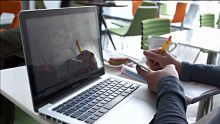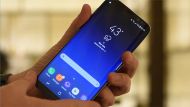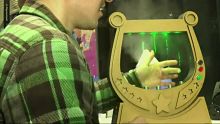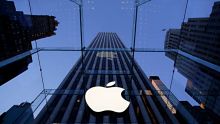After the explosive troubles of last year with the Note7, Samsung's phone fortunes are riding high on the Galaxy S8 and S8+ releases, and they have finally arrived amid much speculation and fanfare here at the launch event in New York.
The S8 shows off the curved glass screen only Samsung can pull off, and the 147mm (5.8 inch) display fills 83 per cent of the front of the phone. There's almost no bezel, fitting more screen into a smaller body. To give you some context, the current champion – the LG G6 – has a 78 per cent screen to bezel ratio, while the front of the iPhone 7 is 65 per cent screen, 35 per cent bezel.
More Digital Life Videos
Hands on with the Samsung Galaxy S8
Peter Wells takes a first look at Samsung's latest mobile device at its New York launch.
The tiny bezel on both the S8 and S8+ combines with the curved glass to create a stunning device that floats in the hand. Samsung calls this "infinity display", a great marketing term, but it really does need to be seen and held to be appreciated. I was smitten with LG's G6, but the S8 has it beat for overall polish, thinness and comfort in the hand.
The main camera on the back of the phone is largely unchanged from the S7, which is a bit disappointing. However the S8's camera is still the best in any Android phone particularly with the on-board optical image stabilisation.
A number of Android phones have moved the fingerprint reader to the back of the phone, which is fine when you have the phone in your hand, but a little cumbersome when trying to open the phone on a desk, or in a car holder. To get around this, the Samsung Galaxy S8 employs Iris detection and facial recognition unlock. I found the Iris detection a bit too much work in last year's Note7, but in the perfect lighting conditions of the demo area, facial recognition unlock worked well. It's a feature that will need to be tested in real world conditions before judging how useful it is.
The two features I was most excited to try were the new personal assistant, Bixby, and DeX, the desktop adaptor that could turn the S8 into a desktop PC "experience".
Bixby was a little underwhelming, perhaps due to the constant hype the newest assistant on the block has received. Samsung describes Bixby as an intelligent user interface, capable of using voice commands to complete any task that you do right now with touch. In the gallery app for example, you can zoom, rotate, and adjust the contrast of an image. That's far more than the current digital assistants on the market can do, but in our demos, Bixby was still a little slow to respond, and the voice assistant sounded quite stilted in her replies. More disappointing, Bixby will be US only at launch – we'll need to wait for the Australian drawl to be translated and understood.
But I have hope for Bixby still – the clunky sounding voice can be fixed with a software update, and there are a few more tricks up its sleeve. Bixby Vision can be used to scan objects or landmarks, or to pull up and overlay information. Again this worked flawlessly in the demo area, but I want to see how it performs in the real world.

In contrast to Bixby, I was blown away by how good the desktop PC experience demonstration was. The DeX unit ($199) is a small circular cradle for the S8 and S8+, with an ethernet adaptor, two USB ports and HDMI connectivity for display. When plugged in, you're still using the Android operating system, but apps are scaled up to fit the desktop screen.
Samsung worked with Microsoft to scale their mobile versions of Office in this mode, and their apps look indistinguishable from regular desktop apps on Windows. The built in browser will present desktop versions of websites, but more impressive was how many apps could be run at one time. As I jumped between Powerpoint, Excel, Word and multiple browser windows while a YouTube clip played in the background, the S8 proved more than capable of keeping up.
The whole thing reminds me of the Elite X3 from HP – the Windows Phone that can expand to a desktop environment when docked. The difference is the X3 is a fantastic Windows Desktop experience that turns into a pretty limited, but powerful, mobile. Here we have a fantastic mobile experience that becomes a limited, but powerful, desktop. Pick your preference.
Samsung needed to impress with the S8 to finally move on from the explosive Note7 debacle of last year. With design alone, they've created the best looking phone on the market, and with DeX, a whole new way of using an Android device.
The Samsung Galaxy S8 and S8+ will go on sale in Australia on Apr 28 for $1199 and $1349 respectively – in black, grey and gold. Plans through major telcos start from $70 a month. Orders will be accepted from Mar 31.
The author travelled to New York as a guest of Samsung.
Does it not bother you that the #Samsung #S8
— Chef MinSun (@coup_detaco) March 30, 2017
do not have a dual camera lens setup? Most flags have dual lens already.
Is not the phone that make me excited, is #Bixby#ai #digitalassistant #S8 #Samsunghttps://t.co/0t0VaZ6HqA
— jarodlkp (@jarodlkp) March 30, 2017
















30 comments
New User? Sign up